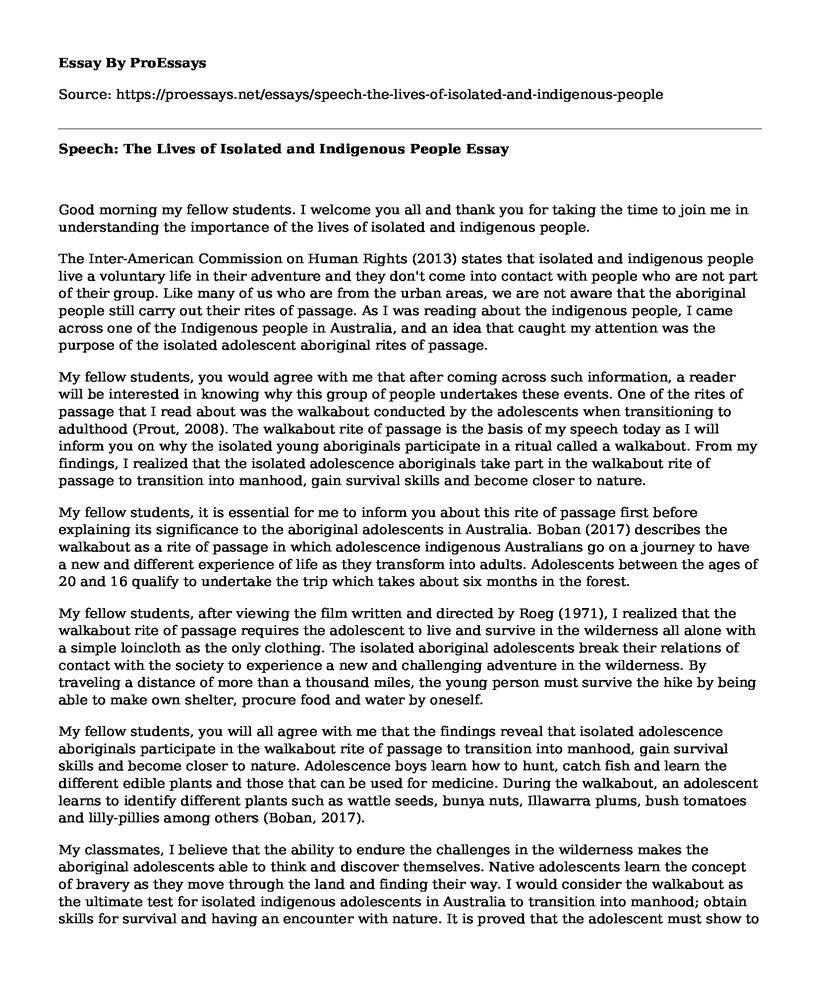Good morning my fellow students. I welcome you all and thank you for taking the time to join me in understanding the importance of the lives of isolated and indigenous people.
The Inter-American Commission on Human Rights (2013) states that isolated and indigenous people live a voluntary life in their adventure and they don't come into contact with people who are not part of their group. Like many of us who are from the urban areas, we are not aware that the aboriginal people still carry out their rites of passage. As I was reading about the indigenous people, I came across one of the Indigenous people in Australia, and an idea that caught my attention was the purpose of the isolated adolescent aboriginal rites of passage.
My fellow students, you would agree with me that after coming across such information, a reader will be interested in knowing why this group of people undertakes these events. One of the rites of passage that I read about was the walkabout conducted by the adolescents when transitioning to adulthood (Prout, 2008). The walkabout rite of passage is the basis of my speech today as I will inform you on why the isolated young aboriginals participate in a ritual called a walkabout. From my findings, I realized that the isolated adolescence aboriginals take part in the walkabout rite of passage to transition into manhood, gain survival skills and become closer to nature.
My fellow students, it is essential for me to inform you about this rite of passage first before explaining its significance to the aboriginal adolescents in Australia. Boban (2017) describes the walkabout as a rite of passage in which adolescence indigenous Australians go on a journey to have a new and different experience of life as they transform into adults. Adolescents between the ages of 20 and 16 qualify to undertake the trip which takes about six months in the forest.
My fellow students, after viewing the film written and directed by Roeg (1971), I realized that the walkabout rite of passage requires the adolescent to live and survive in the wilderness all alone with a simple loincloth as the only clothing. The isolated aboriginal adolescents break their relations of contact with the society to experience a new and challenging adventure in the wilderness. By traveling a distance of more than a thousand miles, the young person must survive the hike by being able to make own shelter, procure food and water by oneself.
My fellow students, you will all agree with me that the findings reveal that isolated adolescence aboriginals participate in the walkabout rite of passage to transition into manhood, gain survival skills and become closer to nature. Adolescence boys learn how to hunt, catch fish and learn the different edible plants and those that can be used for medicine. During the walkabout, an adolescent learns to identify different plants such as wattle seeds, bunya nuts, Illawarra plums, bush tomatoes and lilly-pillies among others (Boban, 2017).
My classmates, I believe that the ability to endure the challenges in the wilderness makes the aboriginal adolescents able to think and discover themselves. Native adolescents learn the concept of bravery as they move through the land and finding their way. I would consider the walkabout as the ultimate test for isolated indigenous adolescents in Australia to transition into manhood; obtain skills for survival and having an encounter with nature. It is proved that the adolescent must show to the elders that he is capable of surviving in a harsh environment in the indigenous land.
References
Boab. (2017). Walkabout - The aboriginal Australian hike that serves as a rite of passage. Outdoor Revival. Retrieved from https://m.outdoorrevival.com/old-ways/extreme-animal-challenges-us.html
Inter-American Commission on Human Rights. (2013). Indigenous Peoples in Voluntary Isolation and Initial Contact in the Americans. Recommendations for the Full Respect of their Human Rights.
Prout, S. (2008). On the move? Indigenous temporary mobility practices in Australia. Centre for Aboriginal Economic Policy Research. The Australian National University.Roeg, N. (1971). Walkabout. Fresh Film Festival 2001.
Cite this page
Speech: The Lives of Isolated and Indigenous People. (2022, Jun 19). Retrieved from https://proessays.net/essays/speech-the-lives-of-isolated-and-indigenous-people
If you are the original author of this essay and no longer wish to have it published on the ProEssays website, please click below to request its removal:
- Research Paper on Building Trust in Law Enforcement
- Essay on Anzaldua and the Deconstruction of Her Binaries
- Research Paper on Jealousy and Relationship Satisfaction
- Increasing Safety and Security in Children Environments Essay
- Essay Sample on Committed Romantic Relationships
- Impacts of Divorce on Family: Data-Backed Analysis - Essay Sample
- Essay Sample on Human Society: Structures & Development Explored







